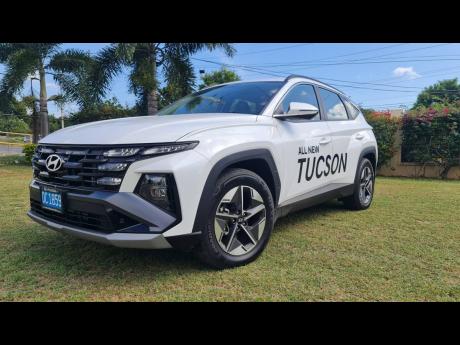Subaru Forester 2.0i-S vs. Hyundai Tucson Diesel 2.0L
The Subaru Forester, launched in 1997, emerged from the Subaru Impreza platform, evolving from a taller station wagon concept into a distinctive crossover SUV. Its production has consistently emphasised practicality, advanced safety, and proven off-road capability, building a solid legacy over several generations. On the other hand, the Hyundai Tucson’s journey commenced in 2004, making it a considerably newer entrant to the compact SUV segment. Its development has spanned multiple generations, each bringing forth enhancements in design, technological integration, and overall performance, with the current iteration adopting a particularly bold and forward-looking aesthetic.
Exterior Designs of Both Vehicles and the Different Design Languages
Subaru Forester: A Sporty Touch
The Subaru Forester 2.0i-S maintains a functional yet appealing exterior. While previous Sport iterations featured a more overtly athletic design, this lower trim retains an attractive presence. Its pronounced wheel arches convey a sense of robustness, contributing to a confident road stance. The integration of modern LED headlights and taillights not only improves illumination but also adds a contemporary visual element, reflecting a design philosophy that prioritises both utility and a touch of sporty refinement.
Hyundai Tucson: Sculpted Sophistication
The 2025 Hyundai Tucson Diesel showcases a highly stylised exterior, defined by sculpted surfaces, flowing lines, and sharp creases. This design approach creates a distinctive visual identity. A particularly striking feature is its front lighting signature, with multiple daytime running lights seamlessly incorporated into the grille. This unique integration ensures that the Tucson is instantly recognisable on the road, contributing to a design language that is both futuristic and impactful, balancing agile proportions with a substantial visual presence.
Interior Features: Comfort, Technology, and Utility
Inside, both SUVs prioritise occupant comfort and technological integration though with distinct approaches. The Forester offers a well-appointed cabin with comfortable, automatically adjustable seats and premium-feeling materials. Its 8-inch touchscreen infotainment system is intuitive, providing Apple CarPlay and Android Auto compatibility for seamless smartphone integration and app display via USB connection. The audio system delivers clear sound, and a generous sunroof enhances the cabin’s airy feel. Excellent all-round visibility is a practical benefit, aiding in maneuverability. The Tucson’s interior, alternatively, features a highly tech-forward design, including an integrated 12.3-inch display that merges the instrument cluster and infotainment system into a single high-resolution interface. It also supports Android Auto and Apple CarPlay flawlessly, with an optional Bose premium audio system for an immersive listening experience. I wished that it didn’t have USB Type-C ports exclusively, however, the reconfigured center console from the previous model creates a more open and spacious feel.
Analyzing cargo space, when the rear seats are folded down, the Subaru Forester achieves a superior maximum cargo capacity of 74.4 cubic feet. However, the Hyundai Tucson offers an advantage with 38.7 cubic feet behind the second row, surpassing the Forester’s 29.6 cubic feet. This makes the Tucson more accommodating for everyday hauls such as groceries or multiple suitcases without needing to fold seats. This substantial difference makes the Forester the more adaptable choice for larger, bulkier items or extensive outdoor gear, highlighting its practical edge for those requiring maximum utility.
Power, Traction, and Ride Quality
When comparing driving dynamics, the two vehicles offer distinct experiences. The Subaru Forester 2.0i-S features a 2.0-litre engine paired with a CVT, delivering smooth and linear power that competently handles inclines. Its outstanding suspension, comprising MacPherson struts at the front and a double wishbone setup at the rear, combined with Subaru’s Symmetrical All-Wheel Drive (AWD), provides exceptional traction and stability on both paved roads and diverse terrains. Driving modes like Intelligent and Sport enhance responsiveness, and X-Mode aids off-road capability.
The Hyundai Tucson Diesel, powered by a 2.0-litre turbo-diesel engine, boasts a robust 183 horsepower while having less torque than the Subaru. Another notable factor is that it is front-wheel drive, which results in more immediate and confident acceleration. The relocated gear selector on the steering column frees up centre console space and side lights that activate with steering wheel turns prove useful on winding roads. The Tucson’s suspension balances comfort and control, effectively absorbing road imperfections though its turning radius could be improved.
From the perspective of driving performance, the Forrester has an advantage where handling and driving comfort is concerned. It garners a significant edge in traction and stability due to its standard Symmetrical All-Wheel Drive system. This system provides superior grip and control, particularly in challenging conditions like rain or on unpaved roads, offering a higher degree of confidence. Furthermore, the Forester’s highly praised suspension system is a standout, delivering a remarkably smooth ride that adeptly absorbs road imperfections. This translates to superior ride comfort over varied road surfaces, which could be a decisive factor for long journeys or areas with less-than-perfect roads.
As for power, the Hyundai Tucson Diesel exhibits a clear advantage in horsepower (183hp vs. 156hp). The inherent nature of a turbo-diesel engine delivers a more substantial and readily available torque output, providing a stronger “push” for quicker acceleration and more effortless climbing on steep roads. This makes the Tucson the more responsive performer for daily driving scenarios and highway merges where immediate power is beneficial.
Subaru Forester 2.0i-S: A Smooth Ride
Engine: 2.0i-S
Horsepower: 156HP
Torque (lb-ft): 144.5
Transmission: Symmetrical All-Wheel Drive (AWD)
Fuel Tank: 63L
Fuel Consumption: 7.29km/l
Hyundai Tucson Diesel 2.0L: Torque and Confidence
Engine: 2.0 Turbo Diesel
Horsepower: 183hp
Torque: 141.7lb-ft
Transmission: Front-Wheel Drive (FWD)
Fuel Tank: 55 litres
Fuel Consumption: 8.929km/L (city)
Subaru:
Kingston Industrial Garage Ltd, Phone: 923-6479, Email: sales@kigjamaica.com
Hyundai:
Magna Motors Dealership LTD, Phone: 630-1511 / 577-3607






